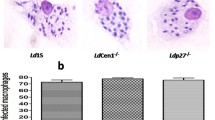Abstract
Visceral leishmaniasis (VL) is a major global health problem but still remains one of the neglected tropical diseases. Currently available chemotherapeutics are associated with severe toxicity and increased drug resistance. There is a need to explore for novel therapeutic strategies that could modulate host immune responses or work in synergy with chemotherapy of VL. Therefore, understanding the host immunological changes that play a vital role in disease pathology is a prerequisite for designing any interventions. We have investigated the role of IL-21 during the course of Leishmania donovani infection and after drug treatment. BALB/c mice were used to investigate the mRNA levels of IL-21 during active Leishmania donovani infection and after treatment using real time polymerase chain reaction (RT-PCR). Mice were divided in four groups i.e. Control (Group A), Infected (Group B), Uninfected treated (Group C) and Infected treated (Group D). Animals of Group C and D were treated with Amphotericin B. IL-21 mRNA levels in the spleen were estimated on days 1, 3, 7, 14, 17, 21, 28, 35, 45 and 60 post infection and also during course of treatment. We found that IL-21 mRNA levels was significantly up-regulated in the infected group with a fourfold increase at D60 p.i. (p < 0.001) and it was decreased significantly after the treatment. Our results suggest that IL-21 mRNA is associated with pathogenesis of Leishmania donovani infection and that therapeutics designed to suppress IL-21 could provide promising antileishmanial activity.


Similar content being viewed by others
References
Ansari NA, Saluja S, Salotra P (2006) Elevated levels of interferon-γ, interleukin-10, and interleukin-6 during active disease in Indian kala azar. Clin Immunol 119:339–345
Ansari NA, Kumar R, Gautam S, Nylén S, Singh OP, Sundar S, Sacks D (2011) IL-27 and IL-21 are associated with T cell IL-10 responses in human visceral leishmaniasis. J Immunol 186(7):3977–3985
Caldas A, Favali C, Aquino D, Vinhas V, van Weyenbergh J et al (2005) Balance of IL-10 and interferon-gamma plasma levels in human visceral leishmaniasis: implications in the pathogenesis. BMC Infect Dis 5:113
Costa DL, Cardoso TM, Queiroz A, Milanezi CM, Bacellar O, Carvalho EM, Silva JS (2015) Tr-1-like CD4+CD25−CD127−/lowFOXP3− cells are the main source of interleukin 10 in patients with cutaneous leishmaniasis due to Leishmania braziliensis. J Infect Dis 211(5):708–718
Croft SL, Sundar S, Fairlamb AH (2006) Drug resistance in leishmaniasis. Clin Microbiol Rev 19(1):111–126
Korn T, Bettelli E, Gao W, Awasthi A, Jäger A, Strom TB, Kuchroo VK (2007) IL-21 initiates an alternative pathway to induce proinflammatory T H 17 cells. Nature 448(7152):484
Melby PC, Chandrasekar B, Zhao W, Coe JE (2001) The hamster as a model of human visceral leishmaniasis: progressive disease and impaired generation of nitric oxide in the face of a prominent Th1-like cytokine response. J Immunol 166(3):1912–1920
Mukherjee P, Ghosh AK, Ghose AC (2003) Infection pattern and immune response in the spleen and liver of BALB/c mice intracardially infected with Leishmania donovani amastigotes. Immunol Lett 86(2):131–138
Murray HW (2005) Prevention of relapse after chemotherapy in a chronic intracellular infection: mechanisms in experimental visceral leishmaniasis. J Immunol 174:4916–4923
Nicolas L, Prina E, Lang T, Milon G (2002) Real-time PCR for detection and quantitation of Leishmania in mouse tissues. J Clin Microbiol 40(5):1666–1669
Niu X, Chen G (2013) IL-21 and related diseases. J Clin Cell Immunol S1:008. https://doi.org/10.4172/2155-9899.S1-008
Osorio EY, Zhao W, Espitia C, Saldarriaga O, Hawel L et al (2012) Progressive visceral leishmaniasis is driven by dominant parasite-induced STAT6 activation and STAT6-dependent host arginase 1 expression. PLoS Pathog 8(1):e1002417
Pavan Kumar N, Anuradha R, Andrade BB, Suresh N, Ganesh R, Shankar J, Kumaraswami V, Nutman TB, Babu S (2013) Circulating biomarkers of pulmonary and extrapulmonary tuberculosis in children. Clin Vaccine Immunol CVI 20(5):704–711
Peruhype-Magalhães V, Martins-Filho OA, Prata A, Silva Lde A, Rabello A et al (2006) Mixed inflammatory/regulatory cytokine profile marked by simultaneous raise of interferon-gamma and interleukin-10 and low frequency of tumour necrosis factor-alpha(+) monocytes are hallmarks of active human visceral leishmaniasis due to Leishmania chagasi infection. Clin Exp Immunol 146:124–132
Pitta MG, Romano A, Cabantous S, Henri S, Hammad A, Kouriba B, Argiro L, el Kheir M, Bucheton B, Mary C, El-Safi SH, Dessein A (2009) IL-17 and IL-22 are associated with protection against human kala azar caused by Leishmania donovani. J Clin Investig 119(8):2379–2387
Rousseau D, Le Fichoux Y, Stien X, Suffia I, Ferrua B, Kubar J (1997) Progression of visceral leishmaniasis due to Leishmania infantum in BALB/c mice is markedly slowed by prior infection with Trichinella spiralis. Infect Immun 65(12):4978–4983
Singh OP, Sundar S (2014) Immunotherapy and targeted therapies in treatment of visceral leishmaniasis: current status and future prospects. Front Immunol 5:296
Spolski R, Leonard WJ (2014) Interleukin-21: a double-edged sword with therapeutic potential. Nat Rev Drug Discov 13(5):379
Stäger S, Alexander J, Carter KC, Brombacher F, Kaye PM (2003) Both interleukin-4 (IL-4) and IL-4 receptor α signaling contribute to the development of hepatic granulomas with optimal antileishmanial activity. Infect Immun 71(8):4804–4807
Sundar S, Chatterjee M (2006) Visceral leishmaniasis—current therapeutic modalities. Indian J Med Res 123(3):345
van Griensven J, Balasegaram M, Meheus F, Alvar J, Lynen L, Boelaert M (2010) Combination therapy for visceral leishmaniasis. Lancet Infect Dis 10(3):184–194
Acknowledgements
Authors acknowledge the Director, ICMR-Regional Medical Research Centre, NE Region, Dibrugarh for providing laboratory facilities to conduct the present study. We also thankfully acknowledge the staff of Animal house facility of ICMR-RMRC, Dibrugarh for taking care of animals during the present study. Rasmita Khatonier thanks Department of Science and Technology (DST), New Delhi for their financial support in the form of DST INSPIRE Fellowship to carry out this study.
Funding
Department of Science and Technology (DST), New Delhi.
Author information
Authors and Affiliations
Corresponding author
Ethics declarations
Conflict of interest
The authors have no conflict of interest.
Rights and permissions
About this article
Cite this article
Khatonier, R., Khan, A.M., Sarmah, P. et al. Role of IL-21 in host pathogenesis in experimental visceral leishmaniasis. J Parasit Dis 42, 500–504 (2018). https://doi.org/10.1007/s12639-018-1025-8
Received:
Accepted:
Published:
Issue Date:
DOI: https://doi.org/10.1007/s12639-018-1025-8




